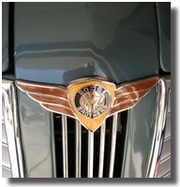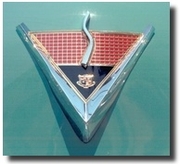Customer CarsMr. D. Upton's '37 Dodge. Enameled emblem restoration by Emblemagic. Mr. J. Irwin's '52 Studebaker. Plastic insert emblem restoration by Emblemagic. Hemmings Articles |
Restoration and Brand Emblems
Whether the car you're restoring is an American muscle car, a foreign performance vehicle, or
a classic auto from an earlier decade, there are several distinctive facets that separate
it from any other vehicle: the lines of the body, the design of the cockpit, the sound of the
horn - on the old Plymouth Road Runner, for example, the horn made a "meep meep" sound instead
of the expected honk, mimicking the cartoon bird that shared it's name.
Of all these distinguishing characteristics, however, one that must never be overlooked is the automobile's emblem. These badges represent not just the model in question, but also the entire brand, and along with the hood ornament are often the most recognizable symbol of any automaker. Sure, slogans like, "See the USA in your Chevrolet," "Pontiac: we are driven," "Oh, what a feeling to drive Toyota," and "the ultimate driving machine," are catchy, but the emblem affixed to a car's hood, trunk, or grille tells a story, and offers a glimpse of history. Consider the Mercedes-Benz logo. There are few people who don't immediately recognize the distinctive three-pointed star (even if they don't think of it as a star), but most may not realize that those three points, which were first seen adorning a Daimler in 1909, and were merged with the Benz laurel wreath seventeen years later when the two companies became one, represents the planned domination of land, sea, and air with their engines. Alternatively, there's a popular legend about the origin of the Chevrolet bowtie that was relayed by journalist Phil Patton in an AIGA publication four years ago. According to this story, GM founder William Durant was visiting Paris in 1907 and became so enamored with the pattern of the wall paper in his hotel room that he stole a sample and tucked it into his wallet. Six years later, he pulled it out and used it as the basis of the emblem for a line of cars named for racecar driver Louis Chevrolet, "…whose name at least sounded French."
Aesthetically, the emblem completes the car, putting the finishing touch on it, and signifying that this is a real antique or classic car, not a kit built to approximate a classic look. In addition, emblems that include numbers in their design tell other folks on the road exactly what you're driving. In the words Mike Bumbeck used in an article for AutoMedia.com, emblems, "… literally spell out what is under the hood. Numbers such as 426, 350, 302, 351, 383 and 502 signify much more than mere integers to muscle car fans, and an SS badge says the small block 350 can lay down the law before the gavel, or as the throttle, comes down." Financially, a restored vehicle with its original badge, shined and polished and gleaming on the fender or grille means that potential purchasers will know they're getting what they pay for. When the emblem is present, it's even possible that you could refinance your classic car or vehicle for more to help with bill consolidation. Minneapolis MN – based MG enthusiast Ben Hutchings explains, "If I see a car that has an original badge and then see a similar model, similarly restored, but without the badge, or where the badge is corroded or damaged, I'm willing to pay more for the first car." Mr. Hutchings isn't alone – the value of the emblem is so great to enthusiasts that there are people who collect just the emblems – never mind the whole car!
The bottom line is this: every classic car is a piece of history - a masterpiece lovingly After all, it's Emblemagic. |
| Copyright © . The Emblemagic Co All Rights Reserved. |
|
|



 Restoration
of an antique vehicle can be a long and difficult process.
Restoration
of an antique vehicle can be a long and difficult process.
 Both of these are great stories, but on the surface, they don't have much relation to restoring a vintage car, right? Actually,
that's not true. When it comes to the fine details of bringing a classic auto back into trim, the emblem is vitally important,
both aesthetically and financially.
Both of these are great stories, but on the surface, they don't have much relation to restoring a vintage car, right? Actually,
that's not true. When it comes to the fine details of bringing a classic auto back into trim, the emblem is vitally important,
both aesthetically and financially.
 restored and tenderly cared for.
Including the emblem in your restoration is the button – the proverbial dot over the "i" and
cross on the "t." Even today, emblems are so important to brand identity that companies like Toyota/Lexus and Honda
spend significant amounts of money to ensure their badges are recognizable, and within the last few years JEEP, which had
never had a logo before, began using one based on extremely-recognizable grille of their Wrangler. Okay, it's not
yet attached to every truck rolling off their conveyor belts, but the fact that it exists says much about the need
for art in advertising.
restored and tenderly cared for.
Including the emblem in your restoration is the button – the proverbial dot over the "i" and
cross on the "t." Even today, emblems are so important to brand identity that companies like Toyota/Lexus and Honda
spend significant amounts of money to ensure their badges are recognizable, and within the last few years JEEP, which had
never had a logo before, began using one based on extremely-recognizable grille of their Wrangler. Okay, it's not
yet attached to every truck rolling off their conveyor belts, but the fact that it exists says much about the need
for art in advertising.

